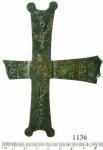Summary (English)
KASTRITSI FORTRESS (Valentin Pletnyov, Maria Manolova-Voikova – mara_manolova@yahoo.de, Igor Lazarenko) A sector situated between the northern street and the fortification wall at the main gate, was explored. Five parallel buildings arranged in a line along the northern side of the street were explored. The buildings were 8 – 10 m by 6 – 9 m in size, with gates towards the street and interconnecting entrances between them. Their walls were 80 cm wide, built of well-cut stones bonded with mud, preserved up to 1.80 m in height. The buildings had two floor levels and respectively, two periods of construction and reconstructions. Identical finds were discovered in both strata: pottery, including sgraffito bowls and dishes, amphorae, and coins of the 14th – 15th centuries, but the difference was that the lower stratum did not contain Ottoman mangir and akçe of the second half of the 14th century. The foundation with the plinth of the fortification wall was explored. A staircase was discovered leading towards the fortification tower above the main gate and the circular bastion to the west of the gate. An important find for the chronology of the Mediaeval fortress was a copper coin of the Bulgarian King Theodore Svetoslav minted in 1300 – 1304, discovered in the mortar layer connecting the Late Antique fortification wall preserved in the Middle Ages and the new Mediaeval wall constructed above it. The finds from the excavations included pottery mainly from the 13th – 14th centuries, including imported sgraffito vessels showing animals or monograms and amphorae, coins: three Hellenistic, 33 Late Roman and Early Byzantine: Constantius Chlorus, Constantine the Great, Constantius II, Valentinian I, Justinian I, Justin II, Maurice and Phocas, 350 Mediaeval coins: Byzantine Emperors Constantine X Doukas, John II Komnenos, Michael VIII Palaiologos, Andronikos II Palaiologos, Andronikos III Palaiologos and Manuel II Palaiologos, Bulgarian Kings Mitso Asen, Theodore Svetoslav, Michael Shishman with Ivan Stefan, Ivan Alexander and Ivan Shishman, Bulgarian Despots Dobrotitsa and Terter, Count Palatine of Cephalonia and Zakynthos John I Orsini, John III of Trebizond, Mircea I of Wallachia and Vlad I of Wallachia, Peter I Mushat of the Moldavian Principality, the Golden Horde, mangir and akçe of the Ottoman Sultans Murad I and Bayezid I and Emir Suleiman, including a hoard of 35 mangir of Emir Suleiman and three copper coins of the Mamluk Sultans of Egypt of the 14th century, a procession cross with Greek inscription that read “St. John the Baptist”, a bronze medallion showing Jesus Christ, exagia, iron tools and earrings.
- Valentin Pletnyov - Regional Museum of History – Varna
- Maria Manolova-Voikova - Regional Museum of History – Varna
- Igor Lazarenko - Regional Museum of History – Varna
Director
Team
Research Body
- Regional Museum of History - Varna






![Download [PDF]](/excavation/skins/fasti/images/results/download_sml.png)

